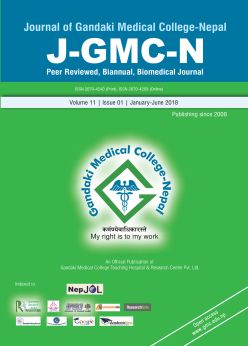Partial Edentulousness in Patients Visiting the Dental Out-Patient Department of Gandaki Medical College, Pokhara, Nepal
DOI:
https://doi.org/10.3126/jgmcn.v12i2.27167Keywords:
Dental caries, Kennedy’s classification, Partial edentulismAbstract
Introduction: Partial edentulousness is a dental arch in which one or more but not all natural teeth are missing due to dental caries, periodontal problems, trauma etc. It causes difficulty in chewing food, alteration of speech and unpleasant esthetics which adversely affect the general health and quality of life.
Methods: This study was conducted in the Department of Prosthodontics, College of Dental Surgery, Gandaki Medical College, Pokhara from November 2017 to March 2018. All patients above the age of 15 years presenting with partial loss of dentition and willing to give informed consent were included in the study. Data regarding age, gender, missing teeth, cause of permanent tooth loss and denture status were collected from 342 patients.
Results: The most common cause of permanent tooth loss was dental caries (58.2%) followed by periodontal (18.1%), dental caries and periodontal (9.4%), trauma (7.9%), dental caries and trauma (2.9%), periodontal and trauma (2.3%) and others (1.2%).The distribution of partially edentulous areas in maxillary arch (35.7%), mandibular arch (45.9%) and both arches (18.4%).The most common type of partial edentulism was found to be Kennedy’s class III followed by class II, class I and class IV in both the arches.
Conclusion: The most common cause of permanent tooth loss was dental caries. Mandibular arch was more affected than the maxillary arch. The most common type of partial edentulism was Kennedy’s class III.
Downloads
References
Bratu E, Bratu D, Antonie S. Classification system for partial edentulism. J Oral Health Dent. 2007;4:50-5.
D’Souza KM, Aras M. Association between sociodemographic variables and partial edentulism in the Goan population: An epidemiological study in India. Indian J Dent Res. 2014;25:434–8.
Batista MJ, Lawrence HP, de Sousa MLR. Impact of tooth loss related to number and position on oral health quality of life among adults. Health Qual Life. 2014;12:165.
Naveed H, Aziz MS, Hassan A, Khan W, Azad AA. Patterns of partial edentulism among armed forces personnel reporting at Armed Forces Institute of Dentistry Pakistan. Pak Oral Dent J. 2011;31:217-21.
Sapkota B, Adhikari B, Upadhaya C. A Study of assessment of partial edentulous patients based on Kennedy’s classification at Dhulikhel Hospital, Kathmandu University Hospital. Kathmandu Univ Med J. 2013;11(4):325–7.
Patel JY, Vohra MY, Hussain JM. Assessment of partially edentulous patients based on Kennedy’s
classification and its relation with gender predilection. Int J Sci Study. 2014; 2:32–6.
Suominen-Taipale AL, Alalen P, Helenius H, Nordblad A, Uutela A. Edentulism among Finnish adults of working age, 1978-1997. Community Dent Oral Epidemiol. 1999 October;27(5):353-65.
Hoover JN, Mc Dermott RE. Edentulousness in patient attending a University dental clinic. J Can Dent. Assoc. 1989 March;55(2):139-40.
Muneeb A, Mohsin B, Jamil B. Causes and pattern of partial edentulism / exodontia and its association with age and gender : Semi rural population, Baqai dental college, Karachi, Pakistan. Int Dent J Students’ Res. 2013;1:13–8.
Akinboboye B, Azodo C, Soroye M. Partial edentulism and unmet prosthetic needs amongst young adult Nigeria. Odontostomatol Trop. 2014;37:47-52.
Bharathi M, Babu KRM, Reddy G, Gupta N, Misuria A, Vinod V. Partial edentulism based on Kennedy’s classification: An epidemiological study. J Contemp Dent Pract. 2014;15:229-31.
Charyeva OO, Altynbekov KD, Nysanova BZ. Kennedy classification and treatment options: A study of partially edentulous patients being treated in a specialized prosthetic clinic. J Prosthodont. 2012;21:177–80.
Downloads
Published
How to Cite
Issue
Section
License
This license allows reusers to distribute, remix, adapt, and build upon the material in any medium or format for noncommercial purposes only, and only so long as attribution is given to the creator.

